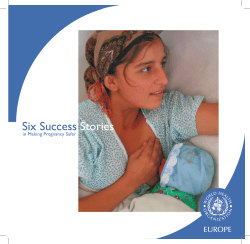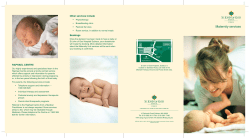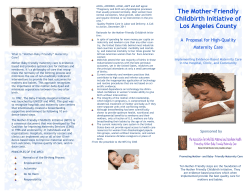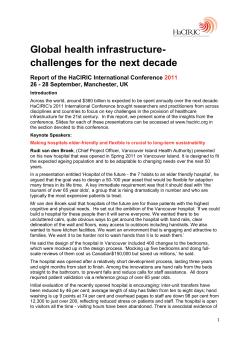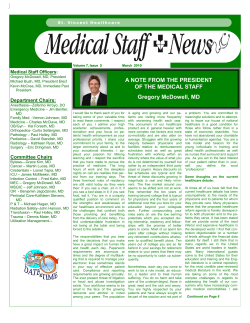
Women’s Healthcare Australasia: Submission to PWC non-admitted patient classification October 2013
Women’s Healthcare Australasia: Submission to PWC non-admitted patient classification October 2013 1 WHA response to the PWC Review of Non-admitted Classifications – Draft Consultation Report Thank you for the opportunity to provide comment on the Review of Non-admitted Classifications (RNAC) – Draft Consultation Report. Women’s Healthcare Australasia is the peak professional body for hospitals providing maternity and women’s health care across Australia. We support our members to achieve excellence in maternity and women’s healthcare through benchmarking performance with one another, networking to share information and expertise, delivering education and training and through advocacy to government, non-government agencies and the community. The RANC Draft consultation report was circulated to a number of member hospitals. The following suggestions and responses reflect the collated feedback from members. 1. WHA supports the summary of findings from the key informant interviews as summarised on page iii of the RNAC draft report. 2. WHA supports the findings from the consultation workshop and associated Principles to consider in the development of a classification system, as outlined on page iii of the RNAC draft report. WHA would like to add the following key elements to the discussion in relation to nonadmitted patient classification. Midwifery Group Practice is evidence driven best practice maternity care - WHA would like to emphasise the benefits to be gained from ensuring that Principle 8 (Page iii) “supporting implementation of improved models of care” is prioritised above the elements of counting service minutes or counting of service episodes in the development of a non-admitted classification system. Midwifery Group Practice (MGP) represents best practice non-admitted patient care for women during pregnancy. Caution needs to be placed on counting minutes of service provided, and classifying this in the same manner as minutes provided through a MGP type model of care. Priority should be placed on an appropriate payment for the best practice model of care above minutes of service. WHA would like to emphasise that gaming occurs where payment for individual services is prioritised over the payment for an episode where continuity of care is provided to the patient. Perinatal transfer services - Arrangements for classification of neonatal retrieval and transfer services vary from state to state. Our members are unclear whether this type of service will fit under the categories listed, as it relates to an admission of a baby to a neo-natal intensive care unit in a referral centre, but is not always funded through the receiving hospital, or through the referring hospital for that matter. Neonatal transfers occur between secondary and tertiary units, but also at times between NICUs, when there is a need to manage fluctuations in demand for access to a NICU cot for all of the babies requiring care at any given time. Women’s Healthcare Australasia | ABN: 50 065 080 239 Suite 1, 1 Napier Close, Deakin, ACT, 2600 | PO Box 50 Deakin West ACT 2600 Ph: +61 2 6175 1900 | Email: admin@wcha.asn.au Web: women.wcha.asn.au Women’s Healthcare Australasia: Submission to PWC non-admitted patient classification October 2013 2 Care of the unwell neonate not admitted to a NICU or Special Care Nursery - It is commonplace that unwell babies who do not ‘qualify’ for admission to a special care nursery but who require specialist treatment, are cared for on the postnatal ward while rooming in with their mothers. Such babies may require a range of treatments such as antibiotic administration, monitoring of glucose levels or phototherapy for jaundice. However these babies are not regarded as admitted patients who attract funding unless they qualify for NICU or SCN admission. NICU resources are increasingly being utilised by the very young premature babies (from 23 or 24 weeks of age) leaving less room for admission of older newborn babies who may nevertheless require specialist input to their care. Specialist care is therefore being delivered on the ward with the babies being non-admitted. This has benefits for the health of the mother and the baby, as well as being a lower cost way of providing the required care. It is currently unfunded. There are already relevant DRGs for the treatments provided which cannot be claimed against unless the baby is admitted to a neonatal nursery as a patient. As we move to Activity Based Funding for maternity and neo-natal services nationally, it is essential that there be recognition of, and funding for, the legitimate costs associated with care of an unwell baby on the ward. Such care is lower cost than a NICU admission, but is currently unfunded (or cross subsidized within hospital budgets by other funded activities). There are health, as well as cost benefits to such specialist care being provided to newborns on the ward, but such care is unlikely to continue unless appropriately funded. Pre- and postnatal home visiting programs - A number of our members provide midwifery care to women in their homes during pregnancy, as well as after the birth of their baby and following discharge from the hospital. Midwives from the hospital visit women in their homes for pregnancy consultations and in the immediate post-natal period. They check on the health of the mother and baby, reduce the risk of re-admission for postpartum infection, support the establishment of breastfeeding and make appropriate referrals to primary health services. Some services also provide home visiting for babies discharged from the Neonatal Intensive Care Unit. It is not immediately clear that the categories listed would capture these important maternity care services, as they are existing services provided by many public hospitals and relate to the non-admitted period. Such services can be particularly valuable for women from socioeconomically disadvantaged communities for whom access to an out-patient service on the grounds of a hospital is problematic, and have been shown to improve health outcomes for both mothers and babies. If such services are not funded, this could result in increased readmission rates. Provision of screening tests - Some of our member hospitals currently provide a range of women’s health screening tests as a means of preventing admissions from the development of undetected infections, cancers or other problems. These are often set up to fill the gap in otherwise funded services. Examples include breast screening, cervical screening and treatment, and sexually transmitted infection screening and treatment. If such services are not counted, there would be a need for alternative funding sources to be identified, lest the absence of such screening services leads to increased ‘end-of-pipe’ admissions. Split payment for service - There needs to be a capacity to split payment for services between providers. An example of this is where the care of newborn babies moves between the hospital setting (non-admitted) and maternal and child health (community) setting. 3. WHA would also like to emphasise the importance of the following elements in deciding on a classification system for non-admitted patients: Women’s Healthcare Australasia | ABN: 50 065 080 239 Suite 1, 1 Napier Close, Deakin, ACT, 2600 | PO Box 50 Deakin West ACT 2600 Ph: +61 2 6175 1900 | Email: admin@wcha.asn.au Web: women.wcha.asn.au Women’s Healthcare Australasia: Submission to PWC non-admitted patient classification October 2013 3 Rurality – Rurality significantly affects the time and type of service delivery provided to the non-admitted patient. WHA recommends that a loading be provided within the classification system for this in future. Indigenous status – Indigenous & Torres Strait Islander status is rarely identified in the nonadmitted patient setting. Rather than enforce additional elements of data collection onto services it is suggested that the Independent Hospital Pricing Authority consider an efficient price adjustment to service provider based on proportion of population served with indigenous status. We are mindful of the ongoing disadvantage such women and babies encounter and a range of strategies are being adopted, trialled and evaluated to help improve these women’s experiences of maternity care, and their ability to care for their newborn baby. Such programs as are already in place necessitate dedicated additional resources being provided to facilitate training for health professionals, induct and support Aboriginal Health Workers, and evaluate their effectiveness over time. Expensive medicines – Classification of non-admitted patient services needs to acquit the cost of expensive medicines utilised to maintain optimal health of the patient. Multi-disciplinary services - WHA supports the reference to multi-disciplinary services within the non-admitted/outpatient setting. The current funding methodology encourages gaming to capture the true cost of providing these services, which is particularly relevant to maternity services. WHA would like to thank PWC for the opportunity to provide comment on this important element in the future of the Australian healthcare system. Julie Hale Deputy Chief Executive Officer Women’s Healthcare Australasia 2 October 2013 Women’s Healthcare Australasia | ABN: 50 065 080 239 Suite 1, 1 Napier Close, Deakin, ACT, 2600 | PO Box 50 Deakin West ACT 2600 Ph: +61 2 6175 1900 | Email: admin@wcha.asn.au Web: women.wcha.asn.au
© Copyright 2025





